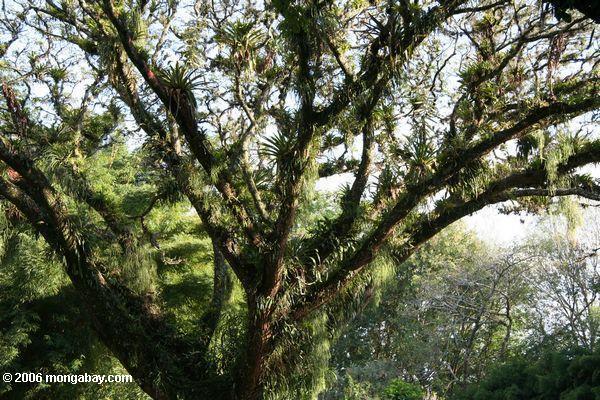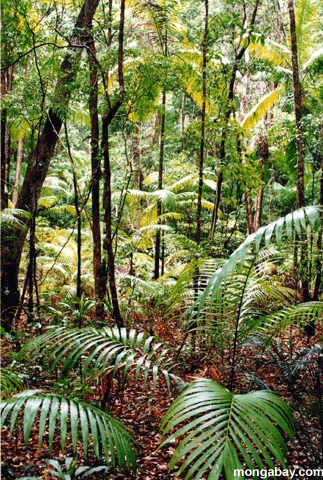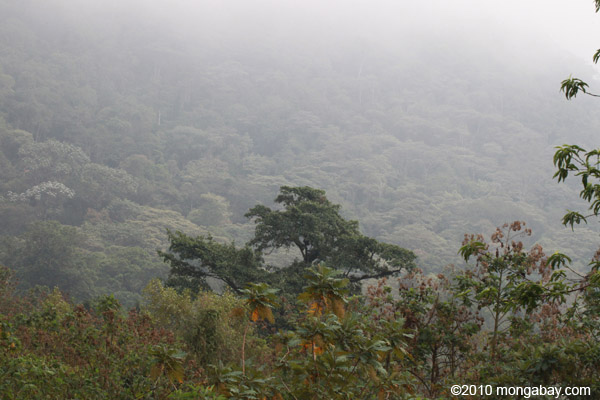- The Wet Tropics of Queensland is home to at least 65 vertebrates found nowhere else in the world.
- New research finds that a large number of Australia’s cloud forest species may be doomed due to human-caused climate change.
- Australia’s cloud forests likely won’t be the only ones affected – for years, scientists have been raising warnings about climate change impacts across the world’s cloud forests.
For over 40 million years, pockets of ancient rainforest have survived on the eastern coast of Australia, sheltering a bewildering array of plants and animal found nowhere else – many believed to be relicts of a bygone era. This little lost world, known as the Wet Tropics of Queensland, has survived multiple climatic and biological upheavals – including the arrival of Homo sapiens – but new research in Biological Conservation has found that a good number of these species may be already doomed due to human-caused climate change.
“This region is home to potentially the oldest or some of the oldest rain forest refugia on Earth,” lead author, Craig Costion with James Cook University, told Mongabay. “By this I mean, areas that have maintained suitable climate to sustain tropical rainforest continuously through time.”
A UNESCO World Heritage Site, the Wet Tropics of Queensland, is home to at least 65 vertebrates endemic to the region – i.e., only found here. And, even more astoundingly, 674 endemic plants. Some of these species survive only in the region’s high-altitude cloud forests.
Cloud forests the world over are known as hugely-biodiverse ecosystems with staggering percentages of endemics. Unique environmental conditions, such as rapidly rising elevations, cool temperatures and near-constant cover in clouds and mist, create mini-evolutionary laboratories even in small cloud forests. But these same environmental conditions make these biodiverse ecosystems particularly vulnerable to climate change. If temperatures rise, species may find themselves with nowhere to go.

To test the effects of climate change on cloud forest species, Costion and his colleagues turned to data on 19 well-known, endemic plant species in the Wet Tropics of Queensland, each inhabiting cloud forest above 1,000 meters. The team then modeled the plants’ habitat requirements against three possible climate change scenarios. What they found was alarming.
“The current climate will virtually disappear by 2080,” explained Costion. “How the endemic species will respond to this change is uncertain but Australians should not be surprised if many of their native endemic species in this habitat disappear with the climate.”
In just 25 years, the climate niche for the species will decline by a mean of 81 percent. One shrub species will likely become extinct, the aptly named Micromyrtus delicata. By 2080, the decline jumps to an average of 95 percent. By then, nine species will have zero habitat – i.e., will likely go extinct – while the rest will see their ranges slashed to the bone. Only one species may be left with half of its range.
“Australia is a unique continent. It doesn’t have many high mountains and has very little rain forest, so the species on Queensland’s mountaintops are essentially isolated with no place to migrate to,” Costion explained.
He added that he wasn’t surprised that their findings were “consistent with previous studies that looked at projections for northeast Queensland’s vertebrates.” However, he added: “we didn’t expect the decline to be so fast.”

One previous study Costion referred to found that the 65 endemic vertebrates in the area were also particularly vulnerable to climate change. Warming of just one degree Celsius – practically inevitable – would possibly send the beautiful-nursery frog (Cophixalus concinnus) into oblivion. The species is currently listed as Critically Endangered by the IUCN Red List. Meanwhile, one degree of warming would drastically reduce the habitat of 63 of the 65 vertebrates.
If temperatures rise by 3.5 degrees Celsius – a catastrophic prospect for human society, according to climate scientists – 30 of the 65 species would lose all of their habitat and face extinction. If seven degrees Celsius – an Armageddon scenario – all 65 species would probably vanish.
“We are facing the complete disappearance of specific environmental types combined with a low possibility of natural dispersal to other suitable habitats…our results suggest that we may be facing an unprecedented loss of biodiversity in any montane biota, an environmental catastrophe of global significance,” wrote the researchers in The Royal Society in 2003.
Costion’s research adds further weight to the likely breakdown of Australia’s cloud forest ecosystems. And the 19 species in his study aren’t the only plants endemic to these high cloud forests. The team identified 13 other species found only above 1,000 meters, but dropped 11 in their modeling due to a lack of enough data and two because of “suspected errors in the collection records.”
Still, Costion cautions that researchers don’t know yet exactly how plants could respond to new, hotter conditions.
“Follow up research is necessary to establish the likely response of these tree species to the predicted changes in climate,” he said. “Some species may be able to adapt better than others, but there is little data available.”
For their study, the researchers assumed that climate conditions were the prevailing factor behind the plants’ distribution, but they think this is a good bet.
“The 19 species represent most of the plants that are restricted to that habitat,” Costion explained in a press release. “It’s highly likely they are found only there because of the climate. There are plenty of other similar soil and substrate environments at lower elevations where they could grow but the climate is unsuitable.”

Even under the most optimistic climate scenarios, the team found that many of these species will face extinction on their respective mountaintops. However, Costion said that doesn’t mean they have to go entirely extinct.
“Australia is equipped with world class Botanical Garden Facilities that have the capacity to maintaining both living collections and seed and tissue bank material from these species,” he noted.
But, of course, that means they would still vanish from the wild and become museum relics, taking with them whatever ecological roles they played in the real world.
Unfortunately, Australia’s cloud forests are not likely to be the only victim. Scientists have been raising warnings about climate change impacts across the world’s cloud forests for years. In 2013, a study in Peru found that cloud forest species attempting to move upslope to keep cool in a warming world would run smack into another ecosystem: puna grasslands.
“Current rapid climate change projections…indicate that these cloud forests will need to move upslope at a very fast pace. Unfortunately, these tree species are not evolutionarily prepared to move this quickly,” said lead author, David Lutz, in 2013. The authors mulled the possibility of hand-moving trees in order to keep them from extinction in the future.

A year earlier, another paper warned that Mexico could lose 80 percent of its cloud forests to climate change. If such predictions prove true, the world could lose innumerable cloud forest species, some still unknown to science.
Yet, at least in Australia, the government is not taking the threat seriously. Experts often cite Australia as one of the industrial countries most vulnerable to climate change. Mostly a hot, arid country, Australia is expected to see drought, desertification and fire increase catastrophically in coming decades.
Despite this, Australia’s government is currently viewed as one of the most obstructive industrialized countries to aggressive action to mitigate climate change. The government, headed by Tony Abbott, is pushing to continue to exploit the nation’s vast coal mines, despite warnings from scientists and the international community.
“Coal is vital for the future energy needs of the world,” Abbott said last year while presiding over the opening of a coal mine in Queensland. “So let’s have no demonization of coal. Coal is good for humanity.”
Yet, a paper last year found that 80 percent of the world’s coal must be left in the ground if countries – including Australia – are to meet their pledge of keeping temperatures from rising above two degrees Celsius.
“Nobody thinks of coal and minerals when they think of Australia but if the Australian government and governments of other industrial nations continue to keep their heads in the sand, that may be all that’s left for future generations in Australia,” said Costion.
And cloud forests may not be Australia’s only victim of rising temperatures. Climate change and ocean acidification, both driven by fossil fuel emissions, are viewed by many scientists as a potential death blow to the Great Barrier Reef.
“Being pro-environment is not bad for the economy or against development, it’s actually being smart about the economy and quality of life for future generations,” said Costion.
xCitations:
- Costion, C. M., Simpson, L., Pert, P. L., Carlsen, M. M., Kress, W. J., & Crayn, D. (2015). Will tropical mountaintop plant species survive climate change? Identifying key knowledge gaps using species distribution modelling in Australia. Biological Conservation, 191, 322-330.
- Lutz, D. A., Powell, R. L., & Silman, M. R. (2013). Four decades of Andean timberline migration and implications for biodiversity loss with climate change. PloS one, 8(9), e74496.
- Ponce-Reyes, R., Reynoso-Rosales, V. H., Watson, J. E., VanDerWal, J., Fuller, R. A., Pressey, R. L., & Possingham, H. P. (2012). Vulnerability of cloud forest reserves in Mexico to climate change. Nature climate change, 2(6), 448-452.
- Williams, S. E., Bolitho, E. E., & Fox, S. (2003). Climate change in Australian tropical rainforests: an impending environmental catastrophe. Proceedings of the Royal Society of London B: Biological Sciences, 270(1527), 1887-1892.